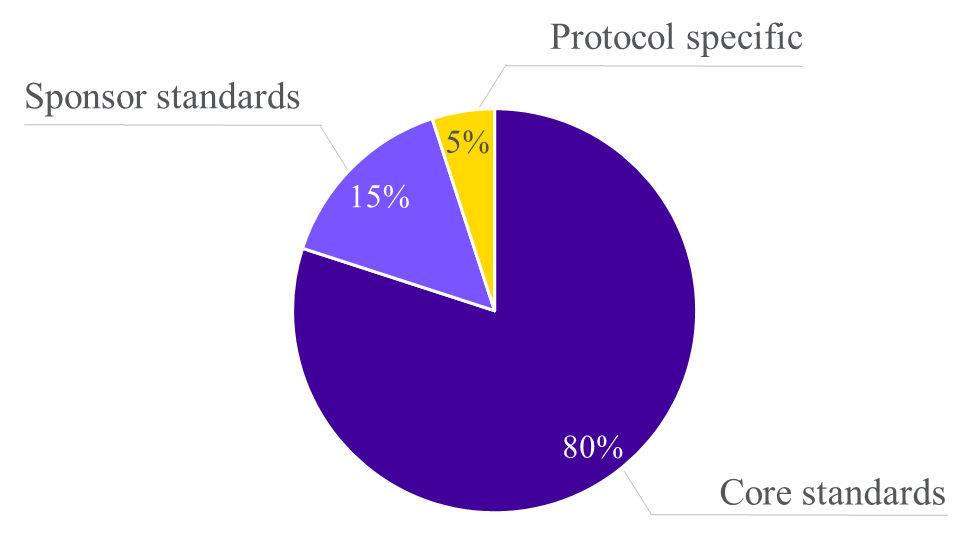Sponsors often ask, “Can we reuse the same IRT settings from a previous trial?” The answer is always yes, shortly followed by a few questions, to refine the scope of what should be reused. Inevitably, preferences emerge and result in less efficiency than the study team was hoping to achieve.
Here we review how defining IRT standards can increase consistency across trials and systematically result in less preferential requirements (often referred to as nice-to-haves), helping trial teams focus on essential protocol requirements (must-haves).
Background
There are typically three levels of functionalities in the IRT system: core standards, sponsor standards, and protocol requirements (figure 1).
Core standards are an integral part of the overall IRT system. They include randomization algorithms, inventory management functionalities and algorithms, inherent system flexibility, drug accountability workflows etc. Core standards should also include integrations with other key systems and vendors, such as EDC and inventory management.
Sponsor standards should encompass commonly used functionalities or settings, such as preferred depot network, inventory management preferences linked to existing processes, etc.
Protocol requirements should be restricted to matching the protocol design with patient dispensing visits and dosing in IRT, defining the randomization and kit lists, configuring integrations that apply to the protocol, and implementing inventory management settings.

“By leveraging IRT standards, development and delivery life cycles will be more streamlined and study data will be more universally useable, repeatable, and transferable within your organization.”
–Kevin Taschereau, Sr. Solution Consultant, Calyx
Benefits of IRT Standards
Apart from helping trial teams focus on protocol-specific requirements, sponsors should realize the following benefits by developing IRT standards:
- Timeline optimization
- Effort reduction in IRT system design
- More efficient User Acceptance Testing
- Consistent data reporting and exchange
- Seamless interactions between IRT vendor and your teams
- Repeatable level of service, across trials and over the years

Figure 1: By aligning standards with the 3 levels of IRT functionality, sponsors improve efficiency during trial start-up and execution and increase repeatability of service across trials.
Recommendations
We recommend that you work with your IRT vendor to collaboratively define your standards. Doing so will ensure your standards are aligned with the core functionality of the IRT solution and make them more robust, flexible, and capable of easily aligning with protocol-specific requirements.
Some of the areas we recommend for standardization include:
- Patient demographics collection
- Specific data format requirements
- Commonly used inventory management settings
- Data transfers and integrations
- Reporting preferences
- User types and access control
Process
To ensure study teams realize efficiencies, standardization should not be limited to the technology aspect. In our experience, platform standardization represents less than half of the standardization focus and we encourage sponsors to spend more time aligning processes with their IRT vendor.
Through establishing key partnerships with sponsors, we’ve seen that process standardization goes both ways. The IRT vendor should adapt their services to fit the sponsor’s SOPs and expectations. Sponsors should also expect to gain a better understanding of the IRT vendor’s processes, which may influence how they interact with IRT as a service.
To illustrate this, at Calyx we have a very structured risk assessment process to identify and mitigate risks related to the IRT system, the protocol-specific randomization and inventory management requirements. Although this process is internal to Calyx, the study team is ultimately responsible for ensuring trial risks are controlled for the duration of the trial. Some of our clients use our risks assessment as an input into their own risk management process as a standard.
As processes are very specific to each sponsor, we cannot anticipate which ones you will want to standardize. However, we recommend that you focus on requirements gathering and UAT phases during IRT system build, encompassing team interactions and documentation.
Another key area to standardize is the communication process with the IRT vendor, both during study start-up and study execution. As you confirm communication requirements, you may realize that you need to define the people aspect.
People
When developing standards with your IRT vendor, it is crucial that you clearly define roles and responsibilities. This will help set expectations both within your organization and with the IRT team. From defining roles and responsibilities, you will inherently define the rules of engagement for the trial setup and execution. As a result, you should experience repeatable delivery from your IRT vendor, regardless of whether your IRT project manager has worked with you in the past. What we find very useful is setting up a template communication plan to define roles and responsibilities, as well as communication paths depending on the trial phase and the situation the trial team is facing.
Although standardization should result in repeatable level of service, independent of the project team, it is no secret that working with the same individuals results in even better consistency over time. Although not necessarily part of standardization per se, we recommend setting up a strong governance team with your IRT vendor, as a point of oversight for non-study activities and any standard future updates.
At Calyx, we have also seen great benefits in aligning our delivery team with a specific sponsor. We have established various types of IRT team alignment, at sponsor, therapeutic area, and program levels and we recommend this approach as a point of discussion with your IRT vendor.
Conclusion
If you are looking to increase efficiency during trial start-up and execution, and increase repeatability of service across trials, standardizing IRT can help achieve your goals.
















